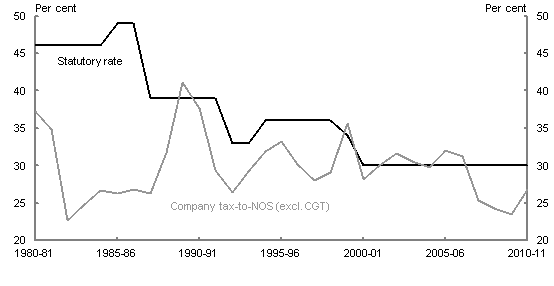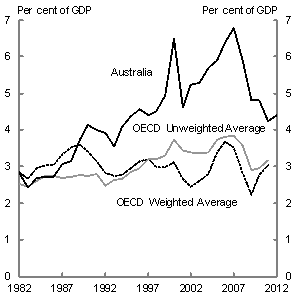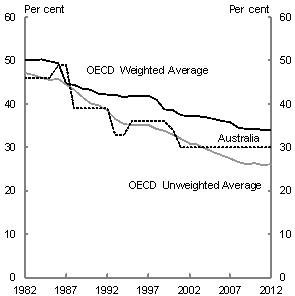- Before assessing the risks to the sustainability of the corporate income tax base, and possible policy responses, it is useful to consider why we have a company income tax in the first place, and how that can operate in an international environment.
- With this in mind, this section briefly summarises the history of company income tax in Australia, including the evolution of international taxation of corporate income and how this compares with international trends.
3.1 Australian Corporate Tax Reform: Broaden Base, Lower Rate
- The Asprey Report generally endorsed the view that it was fairer to impose taxation on income earned by companies at the shareholder rather than company level. However, the report concluded that a key rationale for the taxation of income at the company level was that 'in the absence of company tax, shareholders would be taxed inadequately' (Asprey, 1975, p. 224). In addition to the issue of retained earnings, the Asprey Report found that an 'extremely important' rationale for company income tax was that it:
provides one of the few available means — from the revenue point of view certainly the most significant means — of levying tax on foreign residents deriving income from operations in Australia.
(Asprey, 1975, p. 225) - A key policy theme from the Asprey Report was the need to improve the efficiency of Australia's income tax system by broadening the base to which taxes applied and lowering the statutory rate. The reduction in Australia's company income tax rate from 46 per cent in the mid-1980s to the current rate of 30 per cent reflects this approach, with the reduction in the statutory rate accompanied by the removal of a number of business tax concessions. The net result of this approach is that the average effective rate of company tax has been broadly stable in Australia over recent decades (Chart 1).
Chart 1: Statutory company tax rate and average company tax rate over time

Source: Treasury.
- 23. A similar trend is evident across OECD countries. Company income tax rates have fallen considerably across the OECD in recent decades (Chart 2), with a broadening of the company tax base. The net effect is that company tax revenues as a share of GDP have slightly increased across the OECD over the past three decades, despite headline company tax rates declining (see Chart 3).
Chart 2: Company tax rates (1982-2012)

Chart 3: Company tax revenues as a share of GDP (1982-2012)

Note: Sourced OECD 2009 for OECD data from 1982-2009, OECD 2012 for OECD data from 2010-2011. Economic weights for 2010 have been used for 2011 due to data limitations. Australian data for 2011 and 2012 uses an averaged fiscal year rather than calendar year figure. Australia data to 2012, OECD countries to 2011.
- The rationale for the broad base, low rate approach is that a corporate tax system that applies equally across companies and sectors is more efficient, fairer and ultimately more sustainable. In contrast, anomalies in corporate tax laws typically result in an unpredictable and uneven tax burden across industries and across companies within industries distorting investment decisions, providing unfair competitive advantage to some companies over others and undermining confidence in the tax system and compliance with the tax law.
- The report of the AFTS review endorsed the retention of a broad-based business income tax (AFTS, 2009, p. 25). Moreover, the Report found that economic efficiency would be enhanced if Australia shifted its tax mix away from mobile factors of production (capital, excluding land and natural resources) and towards less mobile factors of production (land, natural resources and labour).
- The AFTS report found that Australia's company income tax rate of 30 per cent was above the average rate for small to medium OECD economies of 25 per cent. The AFTS report recognised the need to balance the benefits of a lower corporate tax rate in attracting mobile factors of production against the implications for the personal income tax and the taxation of less mobile capital. It recommended that Australia's company income tax rate be reduced to 25 per cent over the short to medium term, subject to economic and fiscal circumstances and the imposition of improved arrangements for charging for the use of non-renewable resources.
- In 2011, the Government established the Business Tax Working Group (BTWG) to consider how the business tax system could be improved to make the most of challenges and opportunities arising from the transformations in the broader Australian economy, including the desirability of a cut in the company tax rate accompanied by measures to fully offset the cost. The final report of the BTWG found that 'the business tax base is broader than it was in the 1980s and 1990s and significant savings are now more difficult to identify and reach consensus on'.
3.2 Australia's Approach to International Tax
- Countries exercise their tax jurisdiction based on either a worldwide or a territorial approach — or on a combination of both. Under the worldwide tax approach, a country exercises its sovereign power to tax the income derived by its residents from anywhere in the world, and over income derived by foreign residents from within its borders. Under the territorial tax approach, a country limits its sovereign power to tax to earnings sourced from within its geographic borders.
- When income tax was first imposed in Australia a strict territorial approach was adopted: only income with an Australian source was taxed in Australia.4 In subsequent decades, the direction of reform was towards a worldwide system of taxation, with foreign source income of Australian residents being subject to tax, and withholding taxes imposed on dividends, royalties and interest.
- The peak of the t
rend towards the worldwide approach in Australia was the introduction of the Foreign Tax Credit System from the 1987-88 year of income. Under this system, foreign source income of Australian resident individuals and companies was subject to income tax in Australia, with credit allowed for foreign tax paid (up to the amount of Australian taxation). - Following the Ralph Review and the Review of International Taxation ('RITA') in 2002, the direction of reform has progressively shifted back to a territorial tax approach for the active income of business. In addition to concerns with the complexity of foreign tax credit system, a key goal of these changes was to allow Australian-based multinational enterprises operating in other countries to have the same tax treatment as their competitors in those markets.5
- The net result over time of these changes is that Australia generally applies a worldwide tax approach to individuals and 'passive' business income and a territorial tax approach in relation to 'active' business income earned overseas by Australian resident companies. In effect, 'active' business income earned overseas by a company controlled by an Australian company is generally exempt from tax in Australia (irrespective of whether it is subject to tax overseas).
- Australia's move towards a territorial tax system for active business income is consistent with the general trend away from a worldwide taxation model by OECD member countries. With the recent move towards a territorial approach by the United Kingdom and Japan, the United States remains the only major economy in the OECD that adopts a worldwide taxation principle for corporate taxation.
- Throughout the evolution of the jurisdiction to tax policy, Australia has had rules in place to protect the ability of Australia to exercise its jurisdiction to tax, with these rules being enforced robustly and consistently by tax authorities. In particular, Australia has a long history of actively enforcing 'transfer pricing' provisions to address the challenge of how to ensure that appropriate valuations apply to cross-border transactions and 'thin capitalisation' rules to address profit shifting through the excessive allocation of debt to Australia.
4 Among Australian's first set of tax measures unrelated to excise or customs duties were the broad-based land taxes introduced in the Land Tax Act 1910 and the Land Tax Assessment Act 1910. See, for instance, the Australian Taxation Office (2010, pp. 17-20).
5 That is, Capital Import Neutrality.